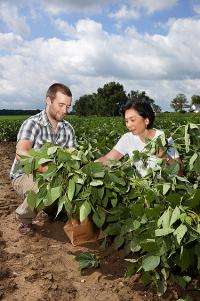Focusing on flood-tolerant soybeans

Soybean varieties that thrive even in soggy fields could result from studies by U.S. Department of Agriculture (USDA) scientists. This would help increase profits for Mississippi Delta farmers who can see yield losses as high as 25 percent when they plant soybean crops in rotation with paddy rice.
This work is being conducted by former Agricultural Research Service (ARS) scientist Tara VanToai, who now works as a collaborator at ARS' Soil Drainage Research Unit in Columbus, Ohio. ARS is USDA's chief intramural scientific research agency, and this research supports the USDA priority of ensuring international food security.
For more than two decades, VanToai has studied flood tolerance in soybeans in a range of environments, including greenhouses, laboratories, growth chambers, experimental fields and farm fields. She and her colleagues are finding and incorporating genes from non-native soybean varieties in an effort to supplement the narrow genetic base of U.S. soybeans and improve their tolerance to wet soil and associated diseases.
In one study, VanToai used outdoor "screenhouses"—which are greenhouses with screens instead of glass—to assess the flood tolerance of 21 soybean lines. This study included soybean lines native to Vietnam and Cambodia, lines developed via selection by farmers and gardeners, and lines from Australia, China, Japan and Taiwan that were created with modern breeding techniques.
The plants were grown in pots. When each plant was in full bloom, it was placed for two weeks in a bucket of water so that the water level was two inches above the soil surface. The screenhouse tests identified the top three flood-tolerant lines: Nam Vang, which is native to Cambodia; VND2, native to China; and ATF15-1, which is native to Australia. Plants from these three lines grew the tallest and produced the biggest seeds and highest yields. When the study was replicated in flooded experimental fields, the results were the same.
More information: Read more about this work and other research VanToai has conducted on soybean flood tolerance in the July 2012 issue of Agricultural Research magazine
Provided by Agricultural Research Service


















